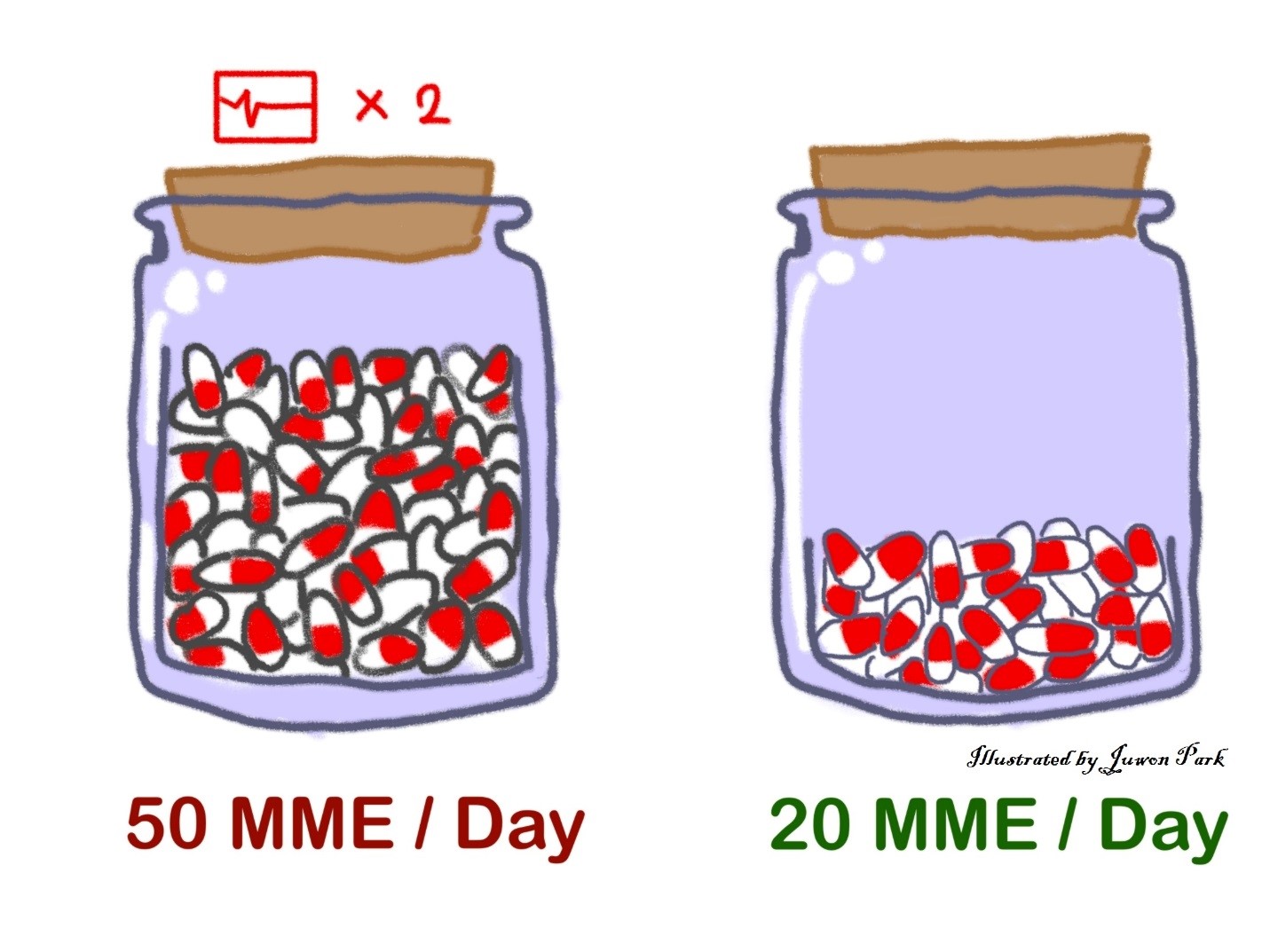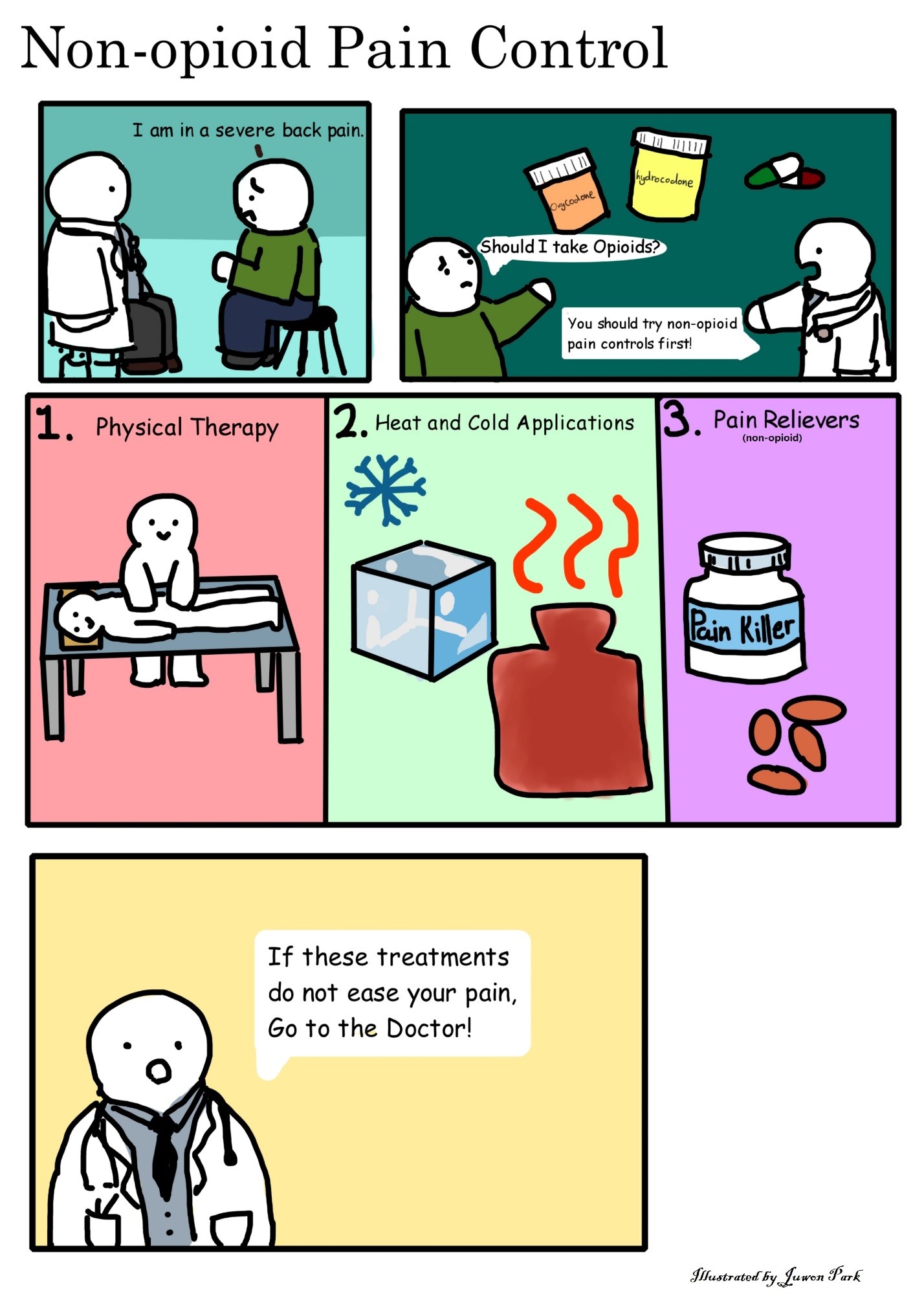Opioid Stewardship
Opioid risks and recommended dosages according to US and Canadian guidelines
Sometimes the best intentions have fatal consequences. Canada and the United States do not have good evidence that they are effective for chronic pain, but they are the two top consumers of prescription opioids. Since there are many different opioids that are used for the same purpose, we use morphine equivalence to compare how strong they are.
AS THE NUMBER OF MORPHINE MILLIGRAM EQUIVALENTS PER DAY (MME/D) INCREASES, THE HARMS ASSOCIATED WITH OPIOID THERAPY ALSO INCREASE.0-50 MME/D
There is no safe dose of opioids. Harms and complications can happen at any dose, but are less likely at lower MMEs/D.
| Codeine Contin 100mg | 2 tabs/day | 30 MME |
| Tylenol #3 | 8 tabs/day | 36 MME |
| 50-100 MME/D |
There is up to a 5x increase in overdose risk in this range as compared to lower doses. Guidelines recommend that prescribing above 90 MME/D be avoided.
| MS Contin 30mg | 2 tabs/day | 60 MME |
| Percocet | 10 tabs/day | 75 MME |
| Hydromorphone 4mg | 4 tabs/day | 80 MME |
| 100-200 MME/D |
There is up to a 9x increase in overdose risk in this range as compared to lower doses. Overdoses that happen at doses greater than 100 MME/D are more likely to be fatal.
| Hydromorphone SR 12mg | 2 caps/day | 120 MME |
| OxyNEO 40m | 3 tabs/day | 180 MME |
| Fentanyl 50mcg Patch | 200 MME | |
| >200 MME/D |
People on higher doses tend to have higher rates of complications like sleep apnea, generalized pain, addiction, low testosterone levels and disability from work. Most chronic pain can be managed well below 200 MME/D.
| Oxycodone CR 80mg | 2 caps/day | 240 MME |
| Hydromorph Contin 30mg | 2 caps/day | 300 MME |
| Fentanyl 100mcg Patch | 400 MME |
Have you been prescribed Opioid for postoperative pain?
Warning:The following are important:
- Never share opioid medications with others.
- Store opioids in a safe place. Keep out of reach of children, teenagers and pets.
- Ask about other options you can use to treat your pain.
- Take any unused medicines back to the pharmacy where they were dispensed for safe disposal. If you have any questions, talk with your pharmacist.
- You have been prescribed opioids. What do you need to know?
Although opioids reduce pain, they do not eliminate all pain. Ask your prescriber about other ways to reduce pain, including ice, stretching, physical therapy, or the use of non-opioid medications such as acetaminophen or ibuprofen. If you know your pain management plan but your pain doesn't improve, work closely with your prescriber.
- How long will you use opioids?
As you recover from a surgical wound, the pain will improve day by day. The better, the less opioids are needed. You can discuss with your healthcare provider how and when to reduce your dose.
- How much is it used at the proper dose? What should I be careful about?
If possible, reduce the amount and time of use as much as possible. Inappropriate use of opioids can lead to overdose and addiction. Avoid alcohol and sleeping pills (such as benzodiazepines such as lorazepam, midazolam) while taking opioids. Do not drive while taking opioids.
- What are the side effects?
Side effects include sedation, itching, constipation, nausea, and dizziness. If there is severe dizziness or if the patient is unable to stay awake during the guardian's observation, the guardian should contact the health care provider.
- How do I follow up pain?
If pain persists after opioid use, ask your prescriber when the pain will improve. If your pain does not improve as expected, let your health care provider know.
Opioids for short-term pain
- You have been prescribed opioids. What do you need to know?
You need to ask your prescriber about other ways to reduce pain, including ice, stretching, physical therapy, or the use of non-opioid medications such as acetaminophen or ibuprofen or naproxen. And ask your doctor, nurse, or pharmacist to find the appropriate medication. If the pain is still severe, use the prescribed opioids. Although opioids reduce pain, they do not eliminate all pain. Opioid medication reduce pain but don't remove all pain. Non-opioids and opioid medications have been prescribed to treat your pain.
- How long will you use opioids?
As you recover from the cause of pain, your pain will improve day by day. The better, the less opioids are needed. You can discuss with your healthcare provider how and when to reduce your dose. Opioids are usually required for less than 3 days for short-term pain. Have a pain control plan and get in touch with your health care provider if your pain does not improve.
- How much is it used at the proper dose? What should I be careful about?
If possible, reduce the amount and time of use as much as possible. Inappropriate use of opioids can lead to overdose and addiction. Discuss with your doctor, nurse or pharmacist about how to use the lowest possible dose for the shortest possible time for all pain medications. Avoid alcohol and sleeping pills (such as benzodiazepines such as lorazepam, midazolam) while taking opioids. It can be dangerous to combine opioids with alcohol or anti-anxiety medications. Do not drive while taking opioids. - What are the side effects?
Side effects include sedation, itching, constipation, nausea, and dizziness. If there is severe dizziness or if the patient is unable to stay awake during the guardian's observation, the guardian should contact the health care provider. It can induce serious side effect like respiratory depression to combine opioids with alcohol or anti-anxiety medications.
- How do I follow up pain?
If pain persists after opioid use, ask your prescriber when the pain will improve. If your pain does not improve as expected, let your health care provider know.
Do you know?
WHY IS IT IMPORTANT TO CALCULATE THE TOTAL DAILY DOSAGE OF OPIOIDS?
Patients prescribed higher opioid dosages are at higher risk of overdose death.
 Dosages at or above 50 MME/day
increase 2 times risks for overdose by at least
compared with less than 20 MME/day.
Dosages at or above 50 MME/day
increase 2 times risks for overdose by at least
compared with less than 20 MME/day.


